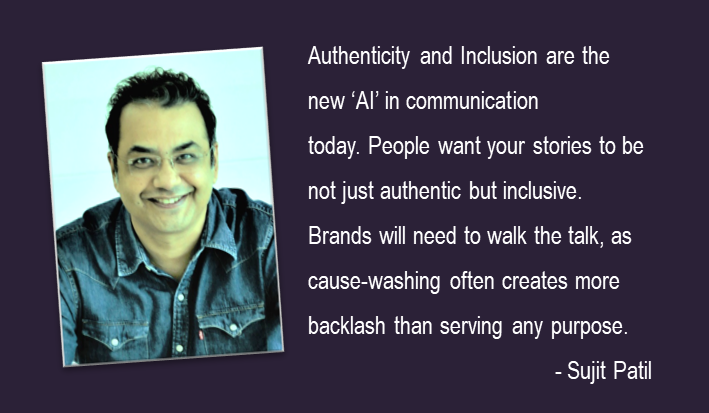Last year same time, in my year end piece on PR and communications trends, I had referred to the transition from 2020 to 2021 as “Pause-activity to positivity”. We started 2021 with a sense of optimism. Now Omicron has struck. Good news is that vaccinations have been impactful, and I am sure, the new variant too shall pass!
My introspection on PR and communications in the year gone by gives me a good feeling. While overall at the strategy level, much did not change, the underlying tenets of communication certainly evolved. On the implementation and process front, a lot of us did go back to the drawing board and have hopefully cracked what really works for our brands.
I am taking the liberty to share eight trends that lie on the intersection of my own analysis of public relations and communications in 2021 and my aspirations for our function in 2022.
Superfluity kills engagement: The time taken for development of a blind-spot in consumers has reduced substantially. Excessive use of any medium or platform can lead to overkill and in return directly impact the engagement rates. An example of this are the virtual meetings. No doubt they have been a necessity, but in a short time, virtual meetings have reached a saturation point. Attention spans have also diminished, and this entails crisp, value adding and to the point information in any narrative.
Shut the microphone and put on the headphones: Listening to your consumers has become more imperative than ever before. Consumers have become vocal of their opinions and more active in participating with a brand in co-creating content. The “Add yours” feature started by Instagram, is aimed at followers co-creating content with brands. Also, with increased vulnerability of brands coming in the cross fires of polarised communities on social media, one needs to be constantly listening to the banter around their brands. You will agree, the time taken for an incident to become a crisis on social media can be a blink of the eye.
‘Authenticity and Inclusion’ are the new ‘AI’ in Communication today: People want your stories to be not just authentic but inclusive. Brands will need to walk the talk, as cause-washing often creates more backlash than serving any purpose. Often, something which is deemed purpose-driven is being construed as opportunistic behavior by your TG. Authentic data backed and research driven narratives will sail well and the reliance on direct-to-consumer communications through owned media properties will go up. So, apply the new ‘AI’.
Rise of geo-focused influence: From the selection of media to the influencers, brands will focus on conquering micro markets through earned efforts. Micro influencers who are native to the geography are turning out to be more impactful influencers that a single, large, pan geography, popular one. Regional influence will go up and hence regional media will come to the fore. Of course, more than influencers thought leaders would be in demand because of their credibility and authenticity. I also see a trend of people trusting people more than company handles and hence active spokespersons handles, and influence would come in vogue.
Metaverse for PR will take shape: Metaverse, an online virtual world that we can gain access to and have experiences using virtual and augmented reality headsets is not a new idea; but has suddenly become a frequent topic of discussion. It can allow brands to tell their stories and connect with consumers in ways unimagined. Imagine, no geographical limitations, direct to consumers, deeper engagement – these are wordings a PR professional craves to hear. The possibilities are immense, and I see increased banter around this subject. Get prepared.
Planning is out, Agility is in: Past two years have prepared us significantly to deal with ambiguities. The number of times campaign dates were changed, or one had to hold back releases or sometimes create one overnight went up significantly. Gone are the days when annual content calendars were adhered to the T. Going forward, the PR turnaround time will be minimised further. An ability to quickly create or change plans in an agile manner will differentiate the good teams from others.
The future of work has arrived ahead of time: On the employee front, we have witnessed myriad return-to-work and employee well-being challenges. The McKinsey Global Institute estimates that over 20 percent of the global workforce could work away from the office and be just as effective. Onboarding new employees with no social, in person contact with colleagues has made integration with organisational culture difficult. Internal communications will have to be redefined to create a shared sense of purpose amongst employees.
Sharpen the best, invest in new and kill the rest: Last two years have provided enough opportunities for us to understand what works and what does not. The ‘Covid cleaning’ has helped eliminate resource draining, non-value adding processes. Investments in CommTech has gone up and thinking around measurement and effectiveness has advanced further. While there is a lot of anecdotal proof available that PR and communications is delivering, the year 2022 will be decisive in terms of proving effectiveness rather than bantering about efficiencies. Working with SMART goals and objectives will prevail.
The pandemic turned the attention of the board towards the CCOs. It is incumbent on us to understand that the relevance gained is not lost. This can happen only when the positioning of the communication function shifts from being a cost-center to that of a value-generator. The biggest challenge will be of earning trust and holding on to it.
2022, I reckon would be the year of ‘systemic renaissance’ for PR and Corporate Communications!
The views and opinions published here belong to the author and do not necessarily reflect the views and opinions of the publisher.






Be the first to comment on "2022 – The year of ‘Systemic Renaissance’ for PR and Communications"